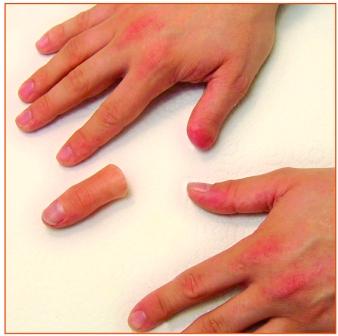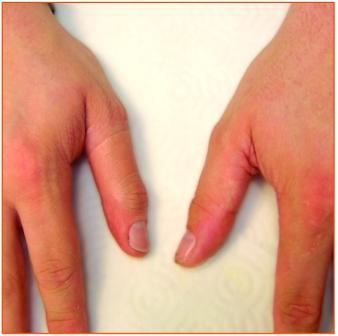What is amputation?
Amputation is the complete removal of an injured or deformed body part. An amputation may be the result of a traumatic injury or may be the result of a planned operation where the finger must be removed. Some traumatically amputated fingers may be replanted or reattached, but in some cases, reattachment of the amputated finger is not possible or advisable. Conditions, such as a tumor, may require that a finger be surgically amputated to preserve a person's health.
How is an amputation done?
When an amputation is necessary, the surgeon removes the injured body part and prepares the remaining part for future prosthetic use. This means careful treatment of the skin, muscles, tendons, bones and nerves, so that a prosthesis can be worn with comfort. The surgeon decides the length of the remaining body part based on medical and prosthetic factors.
What can I expect after surgery?
For the first couple of weeks, you should expect some pain, which is controlled with pain medications. While you are healing, your doctor will tell you how to bandage and care for the surgical site and when to return to the office for follow-up care. You may be given exercises to build your strength and range of motion. You may be asked to touch and move your skin to desensitize it and to keep it mobile.
What type of prosthesis will I get?
The type of prosthesis depends on the location and length of your residual finger or hand and your functional and lifestyle needs. The prosthesis replaces some of the function and the appearance of the missing body part. It is important to communicate to your doctor and prosthetist the activities you feel are most important so that an appropriate prosthesis can be provided for you. Prostheses can restore length to a partially amputated finger, enable opposition between the thumb and a finger, or in the case of a prosthetic hand, stabilize and hold objects with bendable fingers. If your hand is amputated through or above the wrist you may be given a full arm prosthesis with an electric or mechanical hand. Some patients may decide not to use a prosthesis.
How is a prothesis made?
A prosthesis is fabricated from an impression cast taken from the residual finger or limb and the corresponding part on the undamaged hand. Through this process, an exact match to the details of the entire hand can be achieved. The prosthetic finger or hand is fabricated out of a flexible, transparent silicone rubber. Colors dispersed in the silicone are carefully matched to the individual's skin tones, which give the prosthesis the life-like look and texture of real skin. The finger or hand is usually held on by suction. The flexibility of the silicone permits good range of motion of the remaining body parts. Fingernails can be individually colored before applying them to the fingers so they can be matched almost perfectly. The nails can be polished with any nail polish and the polish can be removed with a gentle-action nail polish remover. Silicones are resistant to staining. Inks wash off easily with alcohol or soap and warm water. With proper care a silicone prosthesis may last 3-5 years. Creation of your prosthesis usually begins three months after you are completely healed from surgery. This waiting period allows time for swelling to subside and for the remainder of your hand to take its final shape. You may need therapy to learn to use your new prosthesis.
What kinds of feelings are common following an amputation?
The loss of a body part, especially one as visible as a finger or hand, can be emotionally upsetting. It may take time to adapt to changes in your appearance and ability to function. Talking about these feelings with your doctor or other patients who have had amputations often helps you come to terms with your amputation. You may ask your doctor to recommend a counselor to assist with this process. It is important to remember that with time, you will adapt to your situation by finding new ways of doing your daily activities. A resource that can help is the Amputee Coalition of America www.amputee-coalition.org/index.html. These resources can help you to be strong during the course of recovery. Remember that the quality of life is directly related to your attitude and expectations —not just obtaining and using a prosthesis.

Figure 1: Thumb Prosthesis not attached.

Figure 2: Same hand with thumb Prosthesis attached.